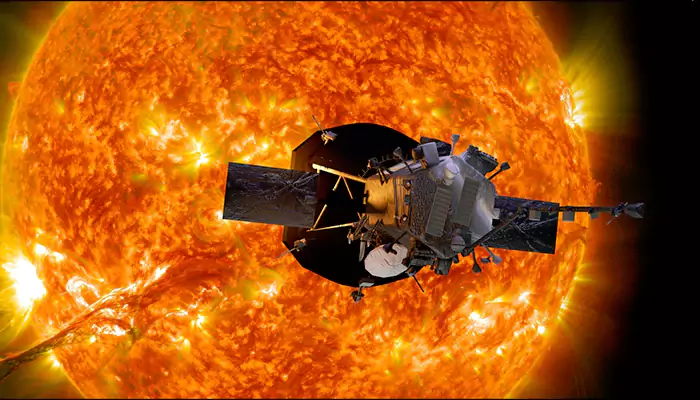Interesting Facts About Parker Solar Probe, The First Spacecraft That Touched The Sun
NASA—on August 12, 2018—launched the Parker Solar Probe—and in 2021, it became the first spacecraft that touched the Sun.
- Satavisha
- 21 May, 2025
- 2 mins ago

Interesting Facts About Parker Solar Probe, The First Spacecraft That Touched The Sun
NASA—on August 12, 2018—launched the Parker Solar Probe—and in 2021, it became the first spacecraft that touched the Sun.
On December 14, 2021, the Parker Solar probe made history by becoming the first spacecraft to touch the Sun. This solar probe by NASA has flown through the upper atmosphere of the sun— the corona—and successfully sampled magnetic fields and particles. Parker has been making groundbreaking discoveries that no other space probe could detect earlier. To gather more information about the first solar probe and its mission—read on.
It is The Fastest Human-made Spacecraft
In the history of space science, this solar probe is the fastest spacecraft. When travelling through the final orbits and is nearest to the Sun, the Parker Solar Probe will accelerate its speed up to 692,000 kph (430,000 mph). To put it in perspective, one can travel from Tokyo to New York in less than 60 seconds.

The Solar Probe Was Named After A Living Person
NASA named this mission after the eminent physicist Eugene Parker—the first person who predicted solar winds. The American space agency named the mission Parker Solar Probe to honour him and his exceptional contribution to the field of science. Parker was able to witness the launch of the spacecraft in 2018.
The Spacecraft is Equipped With Revolutionary Technology.
The solar mission was framed in 1958, but scientists and engineers at NASA took 60 years to design and develop the equipment and technology involved. The solar probe is equipped with an advanced heat shield, a coherent cooling system and an autonomous onboard that ensures the spacecraft is facing the sun.
It Broke Several Records
Only a few months after its launch, the spacecraft became the first man-made object that reached the closest to the sun—passing 42.72 million kilometres (26.55 million miles) from the surface of the hot glowing star. It made another record by becoming the fastest man-made object, travelling at a mind-blowing speed of 153,454 mph.
Since then, the Parker Solar Probe has repeatedly broken its own records, and it will eventually travel at a speed of about 700,000 kmph (430,000 miles per hour) as it approaches the surface of the sun, in 2024.
The Solar Probe Successfully Sampled the Sun.
NASA announced in December 2021—that the solar probe has accomplished its first objective— collecting measurements while travelling within the sun’s atmosphere.
It is Examining Near-light Speed Particles
The solar probe is examining how and why some particles expedite away from the hot star at the centre of our solar system at astonishing speeds—at 90,000 miles per second. These fast-moving particles can reach Earth in less than 30 minutes and can disrupt electronics present in the satellites with almost no warning.
The Parker Solar Probe Can Withstand Extreme Environmental Conditions
The environment within the atmosphere of the sun is extreme—hot and engulfed in radiation—but the solar probe has been crafted to thrive in severe conditions.
The Parker Solar Probe is devised with an advanced heat shield—created by pressing a carbon composite foam between two carbon plates. The exceptionally powerful heat shield’s front side will be exposed to the intense light of the sun—reaching a high temperature of 2,500°F. However, the instruments fitted behind the spacecraft will remain in its shadow—at a temperature of 85°F.
It Will Unveil the Mysteries Of Solar Winds
Currently, scientists have limited understanding of solar wind that occurs in two distinct streams—slow and fast. Experts have identified the origin of the fast solar wind, but they are yet to unveil the mystery associated with the slow solar winds. Parker probe's measurements will shed light on the source of the slow solar winds and answer many questions.
When the Parker Solar Probe runs out of fuel, the spacecraft will turn, and its delicate components will be exposed to the Sun’s deadly force— at close range. The spacecraft will split into big pieces, and the chunks will further break into smaller pieces and continue orbiting the Sun.










